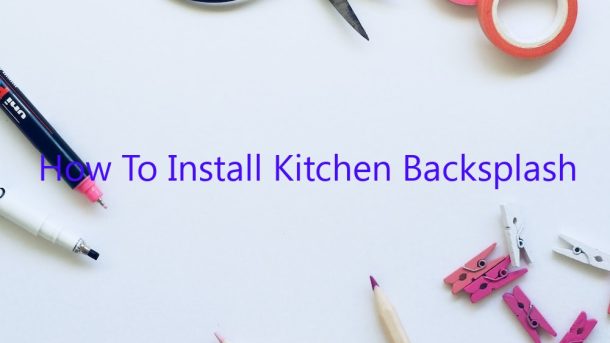Installing a kitchen backsplash is a great way to add personality and character to your kitchen. Not to mention, it can also help protect your walls from food and grease splatters. Here is a step-by-step guide on how to install a kitchen backsplash:
1. Choose the right backsplash material. There are a variety of materials you can choose from, such as ceramic tile, stone, metal, or glass. Choose the material that best suits your style and budget.
2. Measure the area you want to cover. You will need to measure the area to determine how much material you will need.
3. Buy the material. Once you have determined the amount of material you need, go to your local hardware store or home improvement center and buy the material.
4. Prep the area. Before you start installing the backsplash, you will need to prep the area. This includes removing the old backsplash (if there is one), cleaning the surface, and measuring and marking the area for the new backsplash.
5. Install the backsplash. Once the area is prepped, you can start installing the backsplash. Be sure to follow the specific instructions that come with your material.
6. Finish up. Once the backsplash is installed, you will need to finish up by cleaning the area and sealing the tiles, if necessary.
Contents
What is the easiest way to install kitchen backsplash?
Installing a kitchen backsplash can be a daunting task. There are a lot of choices to make and many ways to go wrong. But don’t worry, with a little guidance, you can have a beautiful backsplash in your kitchen in no time.
The easiest way to install a kitchen backsplash is to use pre-made adhesive tiles. These tiles come in a variety of colors and styles, and are easy to install. Simply peel and stick the tiles to the wall, and you’re done.
Another option is to use ceramic or stone tiles. These tiles are usually installed with mortar, which can be a bit more challenging than using adhesive tiles. However, the end result is a more durable and longer-lasting backsplash.
If you’re feeling adventurous, you can also try installing a backsplash made out of metal or glass. These materials require special tools and skills, so it’s best to leave them to the professionals.
No matter what type of backsplash you choose, be sure to plan ahead and take your time. Rushing through the installation process can lead to mistakes and costly repairs. So relax, take your time, and enjoy creating a beautiful new addition to your kitchen.
Can I install kitchen backsplash myself?
Installing a kitchen backsplash is a great way to update your kitchen without spending a lot of money. It can also be a DIY project, which can save you even more money. However, before you start installing your kitchen backsplash, there are a few things you need to know.
First, you need to decide what type of backsplash you want. There are a variety of materials to choose from, including tile, marble, granite, and stainless steel. Once you decide on a material, you need to decide on the style of backsplash. There are a variety of styles to choose from, including mosaic, subway tile, and herringbone.
Once you’ve decided on a material and style, you need to measure the area you want to cover. This will help you determine how much material you need to buy. You also need to determine if you need to hire a professional to help with the installation.
If you decide to install the kitchen backsplash yourself, you’ll need to purchase the materials and tools needed for the job. You’ll also need to read the installation instructions carefully.
If you’re not comfortable installing the backsplash yourself, you can always hire a professional to do it for you.
Regardless of whether you install the backsplash yourself or hire a professional, be sure to read the warranty information for the material you choose. Some materials have a warranty that covers installation.
Where do you start when installing backsplash?
When installing a backsplash in your kitchen, there are a few things you need to take into consideration before you get started. Here is a guide on where to start when installing a backsplash in your kitchen.
1. Measure the Area
The first step in installing a backsplash is to measure the area where you will be installing it. This will help you determine the amount of tile you will need to purchase.
2. Decide on the Design
Next, you will need to decide on the design of your backsplash. This can be a fun process, but you will need to take into account the style of your kitchen and the amount of space you have to work with.
3. Purchase the Tile
Once you have determined the size and design of your backsplash, you will need to purchase the tile. Be sure to purchase extra tile in case of any mistakes or repairs.
4. Remove the old Backsplash
Before you can install the new backsplash, you will need to remove the old one. This can be a challenging process, so be sure to take your time and use the proper tools.
5. Install the New Backsplash
Once the old backsplash is removed, it is time to install the new one. This can be a challenging process, but with the proper tools and instructions, you can do it yourself.
How hard is it to install kitchen backsplash?
Installing a kitchen backsplash can be a daunting task. However, with the right tools and instructions, it can be a relatively easy project.
The first step is to measure the area where the backsplash will be installed. Once you have the measurements, you can purchase the tile and other materials needed for the project.
The next step is to apply a layer of thinset mortar to the wall. Be sure to use a trowel that is appropriate for the size of the tile you are using. Then, begin to install the tile.
Be sure to use spacers between the tiles to create even spacing. If needed, use a wet saw to cut the tiles to size.
Once the tiles are installed, allow the mortar to cure for 24 hours. Then, apply a grout sealer to the tiles to protect them from spills and moisture.
Does backsplash go behind stove?
When planning your kitchen renovation, one of the decisions you’ll have to make is whether to include a backsplash. This is a protective layer that covers the wall behind your stove and countertops. One of the questions people often ask is whether the backsplash goes behind the stove.
The answer to this question is it depends. There are a few things to consider when making your decision. One is the type of backsplash you choose. If you go with a tile backsplash, it will likely cover the entire wall behind the stove. However, if you choose a backsplash made from a material like metal or plastic, it may not go all the way to the stove.
Another factor to consider is the height of your stove. If your stove is relatively low, a backsplash that goes all the way to the stove may not be necessary. However, if your stove is high, you’ll need a backsplash that extends all the way to the top to protect your walls from the heat.
Ultimately, the decision about whether to have a backsplash that goes behind the stove is up to you. If you’re not sure what to do, consult with a professional who can help you make the best decision for your kitchen.
How do you prep a wall for backsplash?
Preparing a wall for a backsplash is a fairly simple process that can be completed in a few hours. The most important part of the process is making sure that the wall is clean and free of any paint, dust, or debris.
If you are painting the wall, make sure it is completely dry before installing the backsplash. If the wall is not painted, you can skip this step.
Next, you will need to measure the area where the backsplash will be installed. This can be done by measuring the height and width of the area, and then multiplying the two numbers together.
Once you have the measurement, you will need to purchase the tile and adhesive that you will be using for the backsplash. It is important to make sure that the adhesive is rated for use with backsplash tiles.
Once you have everything you need, it is time to start installing the backsplash. The first step is to apply the adhesive to the wall. Make sure to use a trowel to spread the adhesive evenly.
Then, place the tiles in the desired location and press them firmly into the adhesive. Make sure to use a level to ensure that the tiles are straight.
Once the tiles are in place, let the adhesive dry for 24 hours. Then, you can apply grout to the tiles. Be sure to follow the instructions on the grout packet, as the process can vary depending on the type of grout you are using.
Let the grout dry for 24 hours, and then you are ready to enjoy your new backsplash!
Does backsplash tile sit on countertop?
Countertops provide a durable and attractive surface for food preparation and other activities in the kitchen. Tile is a common material used for backsplashes, the area behind the stove or sink, because of its durability and easy cleanup. While tile and other materials can be used for backsplashes, there is some debate about whether the tile should sit on the countertop or be attached to the wall.
There are a few factors to consider when deciding whether to have the tile sit on the countertop or be attached to the wall. One is the weight of the tile. If the tile is heavy, it may be more secure to attach it to the wall to prevent it from sliding. Another factor is whether the countertop is granite or other solid surface. If the countertop is not solid, the tile may not sit securely on it and could potentially fall off.
In general, it is recommended that tile be attached to the wall rather than sit on the countertop. This will help to ensure that the tile stays in place and does not create a tripping hazard.




